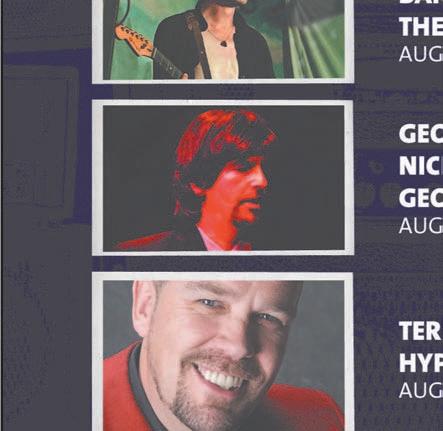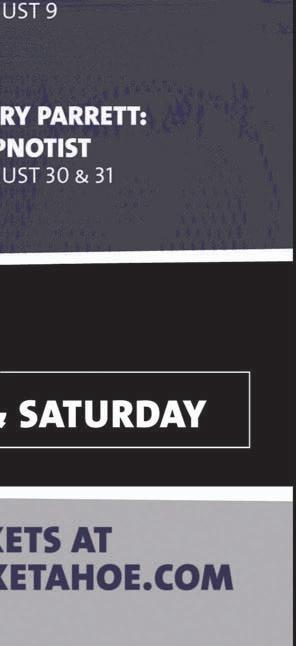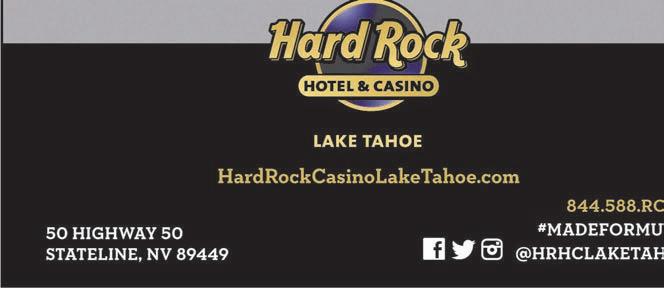
7 minute read
tahOE
from July 25, 2019
Noble art
Wa She Shu It’Deh Arts Festival
Advertisement
For the past 28 years, South Lake Tahoe residents have seen the cultural side of the Washoe Tribe of Nevada and California, and other native tribes, on display in a popular event that showcases the community’s customs and history.
“The arts festival is based in Washoe culture, and this is one of the only times throughout the year where we display it,” said tribal cultural/language resources director Herman Fillmore. “Most of the time we hold it near and dear to our hearts, but we are happy to share it with everyone.”
The 29th Annual Wa She Shu It’Deh Arts Festival returns to the Vahalla/Tallac Historic Site for two days of arts, culture and entertainment. Fillmore said the basket competition is one of the most popular events of the festival. It features weavers from Nevada and California, as well as a few from other parts of the country.
The festival also features dance performances from Agai Diccutta Dancers of Schurz Paiute, Miwok Dancers and Maidu Dancers. There’s also traditional flute music from Paul Stone, round dance songs from the Red Hoop Singers, and Washoe songs from tribal members Darlene Smokey and Itmahawa Enos. Fillmore also said the reggae band playing, False Rhythms, features two tribal members.
Traditional games and stories from the Washoe Tribe will be presented. There is also a fashion show that will display clothing made by Washoe tribe members and designers, a pop-up live art exhibit and an area with food and drink vendors. “We also have arts and crafts vendors with Native American jewelry,” Fillmore said. “A lot of them are from the local tribes, but, for example, we had a Navajo couple that bring up pottery from that area.”
Parking is limited. It should be parking available on the side of Highway 89/ Emerald Bay Road near the site, and there is additional parking across from Taylor Creek. The tribe will have shuttles available to and from the front gate of the festival grounds to parking area.
While music, dance and crafts are the biggest parts of the festival, there is another message and goal for the Washoe Tribe’s event: reclaiming stewardship of the land.
“We really want to leave a small footprint, so we have really increased our recycling efforts this year,” Fillmore said. “We’ve also asked our vendors to use biodegradable items. This is a key piece for us this year, to take up the mantle of being good stewards of Tahoe, as we were the original stewards of that land.”
To that end, there’s an festival educational component. A tribe press release states that the Washoe people “feel it is their responsibility to educate the surrounding communities about the importance of taking proactive steps to protect the natural beauty of Tahoe and the surrounding area.”
There’s also an environmental tie to the arts and crafts themselves. The press release states that “in order for the Washoe traditions to continue there needs to be preservation of all the things that keep the Washoe culture alive, from the willows used to make baskets to the wildlife and habitat that are used in traditional meals and ceremonies. Washoe language and culture is intrinsically tied to their homeland and the people cannot be separated from the land from which they come.” Ω
The basket competition is a highlight of the annual Wa She Shu It’Deh Arts Festival, talking place this weekend in South Lake Tahoe.
COURTESY/WASHOE TRIBE
The 29th Annual Wa She Shu It’Deh Arts Festival takes place from 9 a.m. to 5 p.m. July 27 and 9 a.m. to 4 p.m. July 28 at Tallac Historic Site, 1 Valhalla Road, South Lake Tahoe, California. Learn more about the event and the Washoe Tribe at washoetribe.us.






SPONSORED CONTENT Sierra Nevada Academy Charter School is Changing the World
By Dr. Kim B erly r egan
Energy fills the room as students converse about what they are learning. The classroom--- designed with intimate multi-dimensional work stations, materials intentionally organized to attract learner’s attention and inspire inquiry---is similar to a discovery museum. The teacher, who is conducting a small group power lesson, cannot be easily identified at-first-glance as they blend in with students who are actively engaged. A teacher assistant helps students navigate the Google Jamboard session to develop a presentation on recycling, while a parent is reading to another in the class library. Students are engaged in various self-selected stations to complete or progress their work in: the weekly Lego robotics coding challenge, a simulated survival game promoting stem and literacy, prepping ThinkLaw debate points for the weekly challenge, creating

Students love social media and get in on a group selfie with Dr. regan a diorama for literature analysis, creating a video documentary based on the weekly theme, publishing their book for the Author’s Debut, etc. Several students are at the Choice/ Planning Board where they choose which stations they will work in, ensuring they meet all of the “mustdo’s” within the week. Objectives, expectations, and celebrations of student learning is meticulously displayed around the room. Literature is found in all work stations related to the content. Examples of depth of knowledge and breadth of content covered across the spectrum are evident with the layman’s eye. This classroom experience is the vision of learning at Sierra Nevada Academy Charter School (SNACS). SNACS is changing the world through personalized learning and small school community. SNACS is the first K-8 public charter school (1999) in Nevada and is in the 21st year of operation. Located in the North Valleys of Reno, SNACS is a PLAY® model school where student focus is key to a positive school culture. The acronym PLAY® stands for Promoting Learning and Accountability with Young Children/ Youth where students make decisions about their education, are engaged in hands-on learning experiences, and are accountable. Learning is personalized based on individual data. Work stations (centers) are designed based on state and national standards to meet individualized preferences and differentiated ability needs of students. Students make choices about which projects they will work on within the designated timeframe. The model supports brain development specifically in self-regulation (selfcontrol and time management), executive functioning (memory, rationale, reasoning, and higher order thinking), and metacognition (planning about one’s thinking/ knowledge). The SNACS model is unique and promotes workforce development, college, and career readiness skills. The teacher’s role is to facilitate learning and coach students to make responsible decisions. They are professionals who work in teams to staff students---a SNACS practice similar to a medical team triaging a patient. Teachers review data and discuss student progress, skill-sets, abilities, and interests to design Personal Learning Plans (PLPs) and plan for individual engagement and achievement. Teachers facilitate inquiry-based learning, assess and document student learning, conduct small groups and teach power lessons, and provide individual support while all students are engaged in learning.

Students find spaces to read all around campus promoting literacy Student leaders guide younger students in gardening during nevada agriculture Days

Dr. KimBerly regan is a founder and the Chief Executive Officer for Sierra Nevada Academy Charter School. Dr. Regan has a doctorate in Educational Leadership and is attending Harvard for a post-doc certificate. She is a board member for the Charter School Association of Nevada and a member of the School Leaders Council. She is a past-president for the Nevada Association for the Education of Young Children and has served in state and national leadership roles. Contact Dr. regan via email @ kregan@snacs.org and connect with her on social media via Twitter and instagram @ki_regan
To learn more about SnaCS model visit the website at www.snacs.org or call for a tour today: (775) 677-4500. Follow us on social media on Facebook, Twitter, and instagram via @SnaCSnevada.











